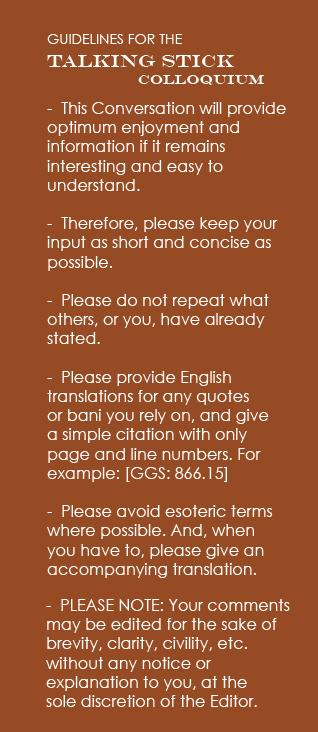Columnists
Kirtan Sohila
The Talking Stick Colloquium # 25, Stanza Five, June 21 - 27
THE DIALOGUE - so far
We have walked through the brief but sublimely beautiful verses of Kirtan Sohila. This short bani which the faithful recite before retiring for the night is an encapsulation of how to live life: fearlessly, with the recognition of the One behind all phenomena; understanding the nature of true worship being in recognizing the mansion of God being deep within the self and ultimately to seize the opportunity.
THE TEXT
In the concluding verse or shabad of Kirtan Sohila, the Guru speaks of human life as an opportunity and pleads with us to make the most of the moment. The opportunity is termed as "sant tahal kÄ« belÄ," or the time (opportunity) to serve the Faithful.
Traditional interpretations, of "to serve" or service (seva) can include physical activity, such as serving the poor, assisting the handicapped, washing utensils or dusting footwear of the sangat - all an integral part of Sikh practice.
Here, we have used the term "walking the way of the Faithful" to distinguish it from actual physical service. Walking the way implies adoption of the life style (mindset) of the Faithful (spiritually elevated souls or Gurmukhs) so that we can seize the opportunity (human life) to reap the spiritual benefit of Naam (the nectar of the mystical Word).
In so doing, we can be assured that our sojourn here will be deemed a success.
The Guru's plea to" maximize our returns" is accompanied by a warning, "Aodh ghatai dinas rainÄre." Time is running out! Heed the Guru and settle your affairs!!
In the previous shabad, we noticed that haumai was described as a thorn in the flesh, constantly pricking and pushing deeper - a constant reminder of pain. Here, the same idea is being reinforced by describing the world as an ocean of doubt and sorrow, "Ih sansÄr bikÄr sansey mÄ—h," or to put it in another way, the thorn of haumai pricking at us in the form of sorrow and doubt distracting us from focusing on the real task at hand.
If we recall the analogy of a city from our discussion last week, the body/mind needs to be ruled by God. In this shabad, we are offered a clue: the mansion of God is deep within the city of the body/mind, "Nij ghar mahal pÄvhu." We can find it using the roadmap of the Guru's wisdom, "har gur te manÄ—h baserÄ."
The roadmap (Gurmat or Guru's wisdom) to God's mansion is made available only through Nadar or Grace, "Jisahi jagÄe pÄ«Ävai ih ras." Those who receive the wisdom are freed from sorrow and doubt and given insight (knowledge) into the ineffable Truth, "akath kathÄ tin jÄnÄ«."
It is this boon that the Guru asks for on our behalf!
LET'S CONSIDER
There is here the notion of an "opportunity" or this human life being the right time. Let's reflect on the nature of this opportunity.
Opportunity also implies possibility or potential. The Guru appears to be suggesting that there are moments of potential and opportunity even during the course of our daily existence. How do we recognize them? What should we look for?
THE TEXT - Rendered in English
RÄg gaoṛī pÅ«rbÄ« mÄ—hlÄ
5.
Raag Gauree Poorbee, Fifth
Mehl
Karao benantÄ« sunho mere mÄ«tÄ sant tahal kÄ« belÄ
Heed my plea, O friends!
Now is the time (to)
Walk the way of the faithful
ĪhÄ khÄt chalhu har lÄhÄ Ägai basan suhelÄ
Earn now your spiritual wealth (and)
The future will be assured
Aodh ghatai dinas rainÄre
Life gets shorter by the day,
Man gur mil kÄj savÄre ||1|| rahÄoll
Heed the Guru (and thus)
Settle your affairs
||1||Pause||
Ih sansÄr bikÄr sanse mÄ—h
tario barahm giÄnÄ«
This world is an ocean of desire and doubt
Only the faithful (brahmgyani) ferry across
isahi jagÄe pÄ«Ävai ih ras akath kathÄ tin jÄnÄ« ||2||
Those who awaken to the nectar of the Name
Discover the ineffable Truth
Ä kao Äe soÄ« bihÄjhahu har gur te manÄ—h baserÄ
Make the trade for which you are here
With the Guru's grace
Find your true home
Nij ghar mahal pÄvhu sukh sÄ—hje bahur na hoigo ferÄ ||3||
Within the self find the mansion of the True One
Dwell in peace and be at rest
Break the cycle of birth and death
AntarjÄmÄ« purakh bidhÄte sardhÄ
man kī pūre
O Inner-knower, Searcher of Hearts, Arranger,
Fulfill my yearning
NÄnak dÄs ihai
sukh
mÄgai mo kao kar santan kÄ« dhÅ«re ||4||5||
Nanak, Your slave, pleads for this boon
Make me as the dust of the Faithful
Conversation about this article
1: Harbans Lal (Arlington, Texas, U.S.A.), June 22, 2010, 1:38 AM.
Ravinder ji, thank you for completing the thread. It was well done and appreciated by many. In the above stanza, the term 'katha' is used. In the Sikh scripture, the term is used for theology. Thus 'akatha katha' will mean 'divine theology'.
2: Aryeh Leib (Israel), June 22, 2010, 4:42 AM.
Does "moments of potential and opportunity" imply that certain hours or days are more auspicious than others? I seem to recall the idea (but, unfortunately, not the source) that the Gurus rejected auspicious days and/or hours that other religions hold so dear. I also find this apparent contradiction in the concept of Amrit Vela being at a prescribed time of day. Would someone be so good as to explain?
3: Ravinder Singh Taneja (Westerville, Ohio, U.S.A.), June 22, 2010, 8:34 AM.
Aryeh Leib ji: from my perspective, "moments of potential and opportunity" is by no means suggesting that certain times (hours) during the day are more auspicious than others. What I had in mind - and perhaps was not clear enough - was that our fears (the subject touched in the first stanza) hold us back from "immersing" ourselves in life generally and backing off from potentially doing specific things (like a career change) - things because we are afraid. Now, I am not suggesting being reckless either, but I hope you get my drift. To the Gurus, only those moments are auspicious when we are linked (liv) to Naam.
4: Ravinder Singh Taneja (Westerville, Ohio, U.S.A.), June 22, 2010, 10:21 AM.
Bhai Sahib: Actually, a thank you is owed, not to me, but to participants like yourselves for the quality and tone of the discussion. My work is relatively simple: I ask the questions and you (the readers) educate me! What a great deal!! THANK YOU, ALL. We intend to continue The Talking Stick Colloquium as long as the Guru allows.
5: Nirmal Singh Nilvi (Texas. U.S.A.), June 23, 2010, 12:08 AM.
There are unique attributes in this stanza for an interpreter to realize and confront. Most of the words and thoughts are simple and easy to interpret. Yet they present seductive temptations to dig deep into the meanings of the words used and complicate the interpretation. The first line paints a clear picture of the intent of Guru Arjan about the subject on his mind and in the last line he reveals the issue. This poetry genre in the sub-continental culture is most often presented as "gazal" and is universally admired. Setting the wording to a music style is a challenge that forces the writer to seek words that can be interpreted beyond the intended purpose, but well managed. Words like "sant tehl ki vela", "akath katha", "tareo brahm giani", etc. are examples to throw the interpreter off base and tempt the mind to dig deeper - if nothing else, just to show the mind's own reach. Otherwise, Guru Arjan has offered us a unique approach to appeal to Akal Purakh in a simple and honest way to ask for very little, and even that most humbly. Which in the essence of what the Sikh scriptures are all about. To seek His grace in whatever we do in life. It is interesting to observe quite often our tendency to turn simple thoughts in gurbani into complicated mind boggling explanations or studies. For what purpose? To show off our haumai-laden minds, intellectual reach or prowess. Aryeh Ji's perceptive question on "vela" was covered in the February 1-7, 2010 discussion on the Japji.
6: Nirmal Singh Nilvi (Texas. U.S.A.), June 23, 2010, 10:44 AM.
The second line in this stanza, "iha khat chalo har laha ..." has received particular attention in Sikh thought and studies. The most often used interpretation leads us to believe that it refers to our actions in this life and that they have consequence in the next life. Perhaps it does, but I have questions on this approach. In a simple way, this does also mean that our actions have consequences in this life as well. Such approach encourages our mind to pay attention to our actions for our own good, and make wiser decisions. And such an approach provides us a higher potential to live a better life. Which we all desire so wishfully. A related point here is for us to view gurbani from a prism of the vast beneficial knowledge it provides for us to use and improve our lives. Sometime I wonder about our practice to view gurbani more from a divine or mystic angle only. I have nothing personal against such approach. Are we emulating a cultural mind-set or religious practices of others around us?
7: Chintan Singh (San Jose, California, U.S.A.), June 23, 2010, 11:39 AM.
Ravinder ji: Although this may be beyond the scope of this discussion, but I am very interested to learn how and who actually compiled these five shabads as the baani of Sohila since three shabads were written by Guru Nanak and the last two by Guru Arjan. I would like to learn how and when these five shabads become the 'Sohila' liturgy and the historical circumstances behind the decision to recite this baani at the end of the day? Thank you.
8: Ravinder Singh Taneja (Westerville, Ohio, U.S.A.), June 24, 2010, 8:58 AM.
Chintan ji: We have Bhai Gurdas' testimony (Vaar 1, Pauri 38) that Sohila (then called Aarti) was recited during Guru Nanak's time. Guru Ramdas and Guru Arjan were not around then, so it is reasonable to assume that the first three shabads were recited. Principal Jodh Singh's examination of the Kartarpur Bir tells us that Sohila - in its present form (5 shabads) - was in the first manuscript of the Guru Granth Sahib. It would be reasonable therefore to assume that the bani had assumed its present form at least by 1604 and that Guru Arjan is the editor of that compilation.
9: Chintan Singh (San Jose, California, U.S.A.), June 24, 2010, 3:11 PM.
Thank you for this information. Greatly appreciate it ... it answers my question. Admittedly, I have only in the last few years started to read Guru Granth Sahib. Understanding it is still a far-stretched dream. Could you be so kind enough to tell me on what 'angs' specifically [pages] are Bhai Gurdas' Vaars? [Editor: Bhai Gurdas' Vaaran are not part of the Guru Granth. They are available in a separate volume. It is a tradition to tackle these Vaars before you venture far into the Guru Granth - they are often dubbed the "Key to Guru Granth Sahib".]
10: Aryeh Leib (Israel), June 24, 2010, 4:20 PM.
Nilvi ji - thank you for the referral to the earlier exhaustive treatment of "vela". That was before I got into this discussion, and I see I've got some catching up to do! I'm learning so much from all of you, and I find you such stimulating and pleasant company. If discussions like this were standard features at every gurdwara, the entire quom would be light-years ahead of where it presently finds itself!
11: Nirmal Singh Nilvi (Texas. U.S.A.), June 25, 2010, 12:20 AM.
As repeatedly written in the Guru Granth, persons who demonstrate thirst for knowledge, wisdom, humility and longing for His grace are held in high esteem in Sikh thought.
12: Ravinder Singh Taneja (Westerville, Ohio, U.S.A.), June 25, 2010, 10:50 AM.
Nilvi ji: "Ihaa khat chalo har laha ..." can be seen as a call to right action (which undoubtedly has consequences here) but also eases the transition into Death (whatever that entails). I think it is easier for an individual to make that transition if there is an accompanying sense of a life well lived; a sense of fulfillment that results from right actions. That is how I read this. So, the real question is: what is the underlying basis for right actions? In the interest of brevity, I will continue this line of thought with another posting - to follow.
13: Ravinder Singh Taneja (Westerville, Ohio, U.S.A.), June 25, 2010, 2:29 PM.
To follow-up: there is an urgency in this verse: of time running out; of identifying and realizing the right end (goal) of life through the right method. This (method or way of life) then becomes the opportunity or possibility, i.e., adopting the right method, also known as "jugat" in gurbani.
14: Mohan Singh (Toronto, Ontario, Canada.), June 26, 2010, 9:58 AM.
As in stanza one, this 5th stanza also reminds us of the end of life. Remember and be attached to God as a gurmukh through your life. 'Akath katha' is - Only those who taste it know its sweet taste, like the mute, who eats the candy, and only smiles, but cannot express his joy in words. [GGS:635]. Again: "Says Kabir, the mute has tasted the molasses, but what can he say about it if he is asked?" [GGS:334] ... and that is 'Laha'. Guru Arjan has also said: "The gurmukhs reap their profits and leave, while the self-willed manmukhs lose it." [GGS: 74]
15: Yuktanand Singh (Saline, Michigan, U.S.A.), June 26, 2010, 1:13 PM.
Books can be written on pre-determination and free will. In a hurry to post it before the week, my message #12 last week may appear as an attempt to explain something that cannot be explained. Meanwhile, gurbani is not just an expression or a theory. We must find its application. So, here is another lame attempt to rationalize why predestination is incomprehensible to us. Dhur karam (purab karam, purab likhia), hukam, and nadar, appear to be different expressions of God's love or God's mercy. Guru Sahib says repeatedly that they are entirely in Waheguru's hands. In fact, Guru Sahib says that nothing we do is in our hands: 'Ehna janta kai vass kisch naahi' [GGS:469.7]. Our ego may view this as an expression of fatalism but, clearly, it is not. If everything is in our father's hands, then all we need is to ask and to make an appropriate effort to receive what we want. If it is good for us, our father gives it to us. Why then does gurbani mention predetermination at all? I suspect that these words are a spontaneous expression of what Guru Sahib saw. The past and the future are like an open book to a Gurmukh. 'They see the past and future but they do not reveal their greatness.' [Bhai Gurdas:14.2.6] They saw that some people make various efforts all their lives but they will never ask, and some ask all their lives but they will fail to ask properly. It appears that in order to teach us how to ask properly, and to keep us humble, free of our ego, God likes to keep his hukam and his nadar totally unpredictable. 'Ayv bhe aakh na jaap-ee ji kissai aa-nay raas' [GGS:463.14] meaning, we cannot predict who gets his favor. We can be sure that God has reasons for this (pure love, perhaps) but we cannot understand his reasons. This changes how we judge ourselves and others, and how we ask. But it should not stop us from asking, or from making appropriate effort on our journey. You may also want to read old article here: http://tiny.cc/t9iaf
16: Nirmal Singh Nilvi (Texas, U.S.A.), June 26, 2010, 5:39 PM.
Ravinder ji has offered us another valuable meaning encased in the line. There are more valuable practical lessons to learn from this stanza. For example, most often we view simple things more casually in life compared to matters what may appear complex. This natural tendency, if not used carefully, can result in overlooking important aspects in simple things. Our interpretation of the words in this stanza perhaps validates this simple truth. Widely used interpretation of these words in Sikh thought imply that we are fortunate to be born as humans and this provides us a chance to escape birth and death cycle, with good deeds. Logic oriented minds would prefer to interpret that each one of us has to evolve our own purpose in life. Both interpretations are equally valid. One interpretation is to adopt a commonly held view of others around us and the other is a reflection of our free will at work. Either way, our approach becomes a reason-based answer to some of the most perplexing thoughts we all encounter in life: why am I born? what is the purpose of life? One interpretation supports religious or divine angle and the other validates culturally held opinion, which advises us to settle down, grow our roots at one place and minimize certain self created hassles in life: moving or running around. The thrust of these thoughts remain the same.
17: Aryeh Leib (Israel), June 27, 2010, 7:41 AM.
I believe that traditional forms of seva can and should be augmented with seva that involves the skills and talents each of us has been given in this existence. This, to me, is the sincerest form of thanks to Waheguru for blessing me with this particular talent, and using it to help others brings it out of the realm of haumai - the pleasure I derive from it.
18: Nirmal Singh Nilvi (Texas, U.S.A.), June 27, 2010, 12:55 PM.
Aryeh ji has made an incisive point on haumai. There is nothing wrong with the haumai faculty itself. Rather, it is one of the most valuable faculties given to humans that have propelled us to accomplish most innovative and challenging tasks. The bad aspects of haumai entail the wrong acts arising out of haumai that we commit against each other. That is why there are no laws or moral codes against haumai itself. Moral codes and laws are against our bad intents or acts arising out of haumai, anger, greed, illicit attachment/ love, grudges, etc. - all emotional traits that are sometimes referred to as the five thieves in Sikh thought. The solution you have suggested is excellent and has existed in the human realm for ever. The human race has not found a perfect way to implement it. Developing the concept of religion is an attempt in that direction. So are moral codes, laws, cultural norms, etc. There is an acute need to develop a new order and it offers us perhaps the most fertile ground for research to develop a new system to save humanity from harming itself.
19: Yuktanand Singh (Saline, Michigan, U.S.A.), June 28, 2010, 5:47 PM.
Ravinder Singh ji: I am delighted to see the progression and participation of our scholars and writers. I am not sure if I should post my notes here or under last week's topic because I feel that we still need to revisit some items from the past. Nilvi ji brought to our attention the 'amrit vela' discussion from February 1-7. (I found S. Karan Singh's message and S. Bal Singh's messages as the most relevant in that discussion.) It is true that all hours of the day and all days of the year are equally auspicious for simran and bhakti, but some times of the day are better suited for meditation. The last part of the night is a special time for the gift of Naam even though we try to repeat it all day. Some people were worried about living where there is no circadian cycle, or if someone worked the night shift. What do the animals and the birds do where there is no circadian cycle? We would not want to eat or sleep just at any time of the day. We try to have a routine, regardless of the length of the day. A non-Sikh, Radha Venkatraman (message #25) appreciated this. All places and all occupations are not suitable for every activity. We cannot expect everyone in the entire world to observe the amrit vela. Living in Antarctica does not change the meaning of gurbani. If we do the best we can, God can change our circumstances and make them favorable. It was also disturbing to see that after years of discussion, people still describe amrit vela as the time 'before sunrise' when gurbani clearly states in several places that the time in question is 'pichhalee raat' (the last part of the night) or before dawn. E.g., GGS:1384.1, 1383.15, and 146.10. The words, 'Fir charhai divuss' [GGS: 305.18] are mistranslated as 'upon sunrise' when they mean 'upon day break' or dawn. Dawn is heralded by the first chirping of birds [GGS:319.9]. After dawn, the mind is much more active ('vagan bahut tarang'). Dawn is not the same as sunrise.
20: Yuktanand Singh (Saline, Michigan, U.S.A.), June 28, 2010, 5:50 PM.
Nilvi ji made another important observation: Looking for some hidden and complex meaning, we miss the obvious. Modern education can make people feel that if they did not understand something in gurbani, then it must be metaphoric and it must have a complex meaning. Gurmat (Guru's teaching) is simple. But it is a subject of the spirit. Education cannot enhance spiritual awareness. Gurbani says that our future hinges upon our spiritual health. In other words, we are judged in the light of Naam: 'Likh naavai dharam bahaliya' [GGS: 463.18]. Morality is necessary but it is not the goal. As they say, teach a man how to fish and you have fed him for a lifetime. Thus, correction at the root corrects all the other errors naturally. Otherwise the correction is artificial and temporary. We are spiritual beings having an earthly experience and we do not have much time ('aodh ghatai dinas raina-ray'). Gurbani also says: 'kauh kabeer eh raam kee uns' [GGS: 871.7] - meaning, "This self/soul is God's offspring'. We are here to reclaim our identity, not to learn how to balance our checkbook calmly, or how to live morally and peacefully with our neighbor, or how to feed the hungry. These virtues are natural when we have learned to earn the wealth of self-realization ('har laha') with the 'sant' as our role model. Those who accumulate this wealth live happy when they return home ('aagai basan suhela').
21: Yuktanand Singh (Saline, Michigan, U.S.A.), June 28, 2010, 5:54 PM.
I need to catch up with my CME and some other deadlines. So, I would like to take a break after my comments today. I am beginning to feel that I am the only one objecting but an important part of the 'jugat' or the method prescribed in the last two shabads of sohila was completely missed during the last two weeks' discussion. The last two shabads stressed a step: sadh sangat. 'Sant tehal ki bela' means that the time to do so is now, in this life time. Waiting for others to chime in, we did not discuss 'charity', one of the building blocks of our city. Swami Vivekananda used to say that the gift of 'brahm gyan' (self realization) is the greatest charity one can receive. Similarly, in the fourth shabad we read: 'Approach the saadhu with your hands clasped, this is a great charity. Prostrate yourself, this is the greatest charity'. Last week we read again: 'Listen to my plea, my friend; this is the time to serve the sant'. Sant, saadhu, junn, brahmgyani, gurmukh, gursikh, sikh, sangat, sadh sangat, and sat sangat occur on each page of Guru Granth Sahib, because all these are extensions of gurbani. The boundaries between these are obscure and blurry. English language has no equivalent for these words. Guru Sahib says in sukhmani: 'jan kai sang chit aavai naa-o' [GGS:295.1] meaning that, in the company of 'junn' - God's servant(s) - we learn how to dwell in Naam. Meeting our role models and walking on their path is the greatest charity, because then we learn and we can teach how to fish (Naam juppna). Guru Sahib says, 'Naam dwelling in our heart is the real seva and real service' [GGS:34.14].
22: Yuktanand Singh (Saline, Michigan, U.S.A.), June 28, 2010, 5:57 PM.
Notwithstanding the 'sant baba' shops that we see in each village these days, and despite the various splinter groups with human gurus attempting to swallow the Sikh panth, Sikhi is a living path. This means that some rare individuals actually do live like true Sikhs. Guru Sahib says, 'I humbly bow and touch the feet of every gursikh I see' [GGS:763.1]. But due to serious flaws in our thinking, it is almost impossible to find such a Sikh or a Gursikh these days. A jathedar of a takht may be less a Sikh than the unknown poorly educated janitor who humbly sweeps the floors and meditates during the pre-dawn hours without any pomp and show. The bulk of gurbani extols meeting these living Sikhs or being in sadh sangat. Some people chant the verse that gurbani is everything and we need to do only what gurbani says [GGS:982.11]. In the same breath they also say that gurbani did not mean what it says, that the words like 'sant' were used only for Guru Sahib. If the ideal described in gurbani does not exist in flesh, if it did exist we cannot find it, and if we find such people we should ignore them because we should not adore them, then we are spiritually dead. We are living make-believe Sikhi because, day and night, we sing praise of people who exist only in our imagination, if at all. Then we compensate for this emptiness by teaching others how to be good Sikhs. Well done!
23: Yuktanand Singh (Saline, Michigan, U.S.A.), June 28, 2010, 6:00 PM.
Sorry if I bored everyone with the spiritual aspect of gurbani. A 'sant' is a perfect soul. I will copy edited portions of S. Harkinder Singh's message here from GLZ: Definition of sant is given in slok sehaskriti [GGS:1357.9-12] - 'Khat lakhan pooran purkheh Nanak naam Sadh svjjneh||' There are six signs of a sadhu (sant) enumerated very beautifully: a) "Mantr ram naamun dhyaan sarbattr poorneh". That is, through the medium of Raam Naam, that person concentrates the attention of consciousness on all prevading entity. b) "Gyan sam dukh sukhum jugat nirmal nirvairneh||" The second attribute of sadh/sant is that this person's reaction to pain and joy is neutral, and follows methodology of no vengeance towards all. c) "Dyaal sarbattr jeeaa panch dokh bivarjteh"|| The third quality is that this person shall be compassionate towards all beings, and must be free of the five elements that sway normal minds: Kaam Karodh Lobh Moh Ahunkaar. d) "Bhojanum gopal keertum alap mayaa jal kamal rahatteh||". Wah Wah, the fourth attribute is this one! That such individual shall have their sustenance in reflecting upon and singing unlimited attributes of Waheguru. They shall live this life unattached like a lotus flower in water is above water but still has its roots in the quagmire of algae, frogs and mud. e) The fifth quality of a sant: "Updes sam mittr sattreh bhgwant bhagat bhavni" - Such sadh/sant shall not have any preferences for friends or dislike and animosity towards some. But rather, shall encourage all to sing the praises of Waheguru with devotion and love. f) The sixth quality of a sadh/sant: "Par nindaah neh srot sarvanum/ aap tyaag sagal reinkeh||" The sixth attribute of a sadh/sant is that this person shall not indulge in listening to slander. They shall not be self-conceited, rather, become humble dust of all. (End of quote) The secret of this unspeakable tale (akath katha) lies in the path of a brahmgyani or a sant. We pray that we learn how to be in the dust of their feet, literally. This is why: 'Nanak daas ehai sukh maagai mokao kar santan kee dhooray' [GGS:13.19].
24: Soorma Sher (Red Deer, Alberta, Canada), June 29, 2010, 11:06 AM.
Very inspiring. The reality is that Sikhs have startted treating Sikhi as an intellectual pursuit rather than an actual way of life. Sikhi's foundation is jupp and simran - and it's not the same as reading paatth from a nitnem gutka. While listening to an earlier recording of Giani Sant Singh Maskeen, he rues the loss of jupp from the Sikh world. And how he has tried to find a brahmgyani in our community but couldn't find one. May be others have had a different experience and have found some true brahmgyanis (sants) within the community. But the reality is this - one of Sikhi's foundation rests on jupp. Amrit Velaa juppna is the single most important first step in the start of a Sikh's journey. But it's hard. Harder than reading the nitnem baanis. Much harder than doing seva. And far harder than intellectually 'understanding' Sikhi. Jupp is the beginning of the first grade, everything else is really pre-school stuff. And jupp is the vehicle that will take us to the ultimate destination, as has been repeated in so many ways and forms in Guru Granth Sahib.




